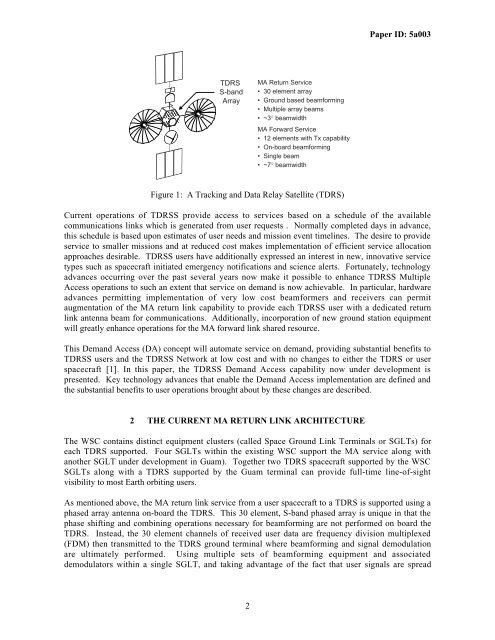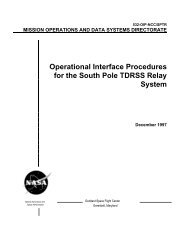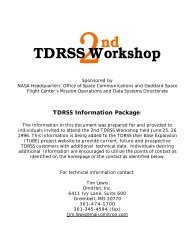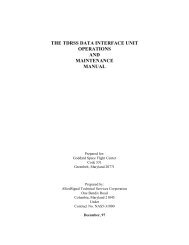TDRSS Demand Access Service: Application of Advanced Technology
TDRSS Demand Access Service: Application of Advanced Technology
TDRSS Demand Access Service: Application of Advanced Technology
You also want an ePaper? Increase the reach of your titles
YUMPU automatically turns print PDFs into web optimized ePapers that Google loves.
TDRS<br />
S-band<br />
Array<br />
2<br />
MA Return <strong>Service</strong><br />
• 30 element array<br />
• Ground based beamforming<br />
• Multiple array beams<br />
• ~3° beamwidth<br />
MA Forward <strong>Service</strong><br />
• 12 elements with Tx capability<br />
• On-board beamforming<br />
• Single beam<br />
• ~7° beamwidth<br />
Figure 1: A Tracking and Data Relay Satellite (TDRS)<br />
Paper ID: 5a003<br />
Current operations <strong>of</strong> <strong>TDRSS</strong> provide access to services based on a schedule <strong>of</strong> the available<br />
communications links which is generated from user requests . Normally completed days in advance,<br />
this schedule is based upon estimates <strong>of</strong> user needs and mission event timelines. The desire to provide<br />
service to smaller missions and at reduced cost makes implementation <strong>of</strong> efficient service allocation<br />
approaches desirable. <strong>TDRSS</strong> users have additionally expressed an interest in new, innovative service<br />
types such as spacecraft initiated emergency notifications and science alerts. Fortunately, technology<br />
advances occurring over the past several years now make it possible to enhance <strong>TDRSS</strong> Multiple<br />
<strong>Access</strong> operations to such an extent that service on demand is now achievable. In particular, hardware<br />
advances permitting implementation <strong>of</strong> very low cost beamformers and receivers can permit<br />
augmentation <strong>of</strong> the MA return link capability to provide each <strong>TDRSS</strong> user with a dedicated return<br />
link antenna beam for communications. Additionally, incorporation <strong>of</strong> new ground station equipment<br />
will greatly enhance operations for the MA forward link shared resource.<br />
This <strong>Demand</strong> <strong>Access</strong> (DA) concept will automate service on demand, providing substantial benefits to<br />
<strong>TDRSS</strong> users and the <strong>TDRSS</strong> Network at low cost and with no changes to either the TDRS or user<br />
spacecraft [1]. In this paper, the <strong>TDRSS</strong> <strong>Demand</strong> <strong>Access</strong> capability now under development is<br />
presented. Key technology advances that enable the <strong>Demand</strong> <strong>Access</strong> implementation are defined and<br />
the substantial benefits to user operations brought about by these changes are described.<br />
2 THE CURRENT MA RETURN LINK ARCHITECTURE<br />
The WSC contains distinct equipment clusters (called Space Ground Link Terminals or SGLTs) for<br />
each TDRS supported. Four SGLTs within the existing WSC support the MA service along with<br />
another SGLT under development in Guam). Together two TDRS spacecraft supported by the WSC<br />
SGLTs along with a TDRS supported by the Guam terminal can provide full-time line-<strong>of</strong>-sight<br />
visibility to most Earth orbiting users.<br />
As mentioned above, the MA return link service from a user spacecraft to a TDRS is supported using a<br />
phased array antenna on-board the TDRS. This 30 element, S-band phased array is unique in that the<br />
phase shifting and combining operations necessary for beamforming are not performed on board the<br />
TDRS. Instead, the 30 element channels <strong>of</strong> received user data are frequency division multiplexed<br />
(FDM) then transmitted to the TDRS ground terminal where beamforming and signal demodulation<br />
are ultimately performed. Using multiple sets <strong>of</strong> beamforming equipment and associated<br />
demodulators within a single SGLT, and taking advantage <strong>of</strong> the fact that user signals are spread






